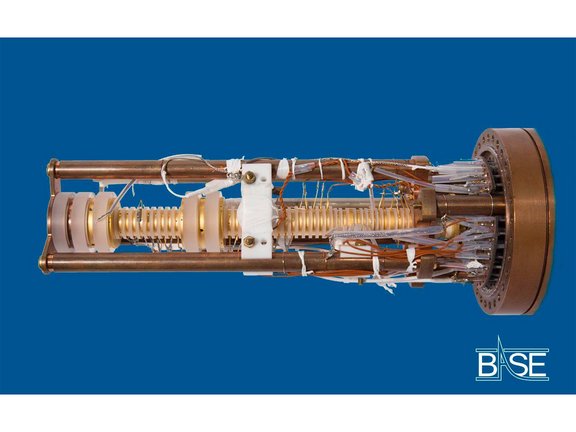A study that takes a novel approach to the search for Dark Matter has been performed by the BASE Collaboration at CERN. For the first time the researchers are exploring explicitly how Dark Matter influences antimatter instead of standard matter. Their findings are now published in the latest edition of Nature.
To date, scientists have always conducted high-precision experiments at low energies using matter-based samples in the hope of finding a link to Dark Matter. The present experiment is searching for the first time explicitly for interactions between Dark Matter and antimatter. It is generally assumed that interactions of Dark Matter will be symmetric for particles and antiparticles. This is tested in the new study.
The project’s participants in fact see a double benefit in this approach: Little is known at this point about the microscopic characteristics of Dark Matter. At present one much-discussed possible component of Dark Matter is what is known as ALPs (axion-like particles). Moreover, the standard model of particle physics offers no explanation of why there is apparently so much more matter than antimatter in our universe. The experiments may help to find clues that could provide a link between these two aspects.
Captured antiprotons could deliver insights into Dark Matter
The scientists are focusing their attention on one single antiproton that has been captured in the BASE Collaboration’s trap system. The particle was produced in the Antiproton Decelerator (AD) at CERN, the world’s only research institution capable of generating low-energy antiprotons. An antiproton has both a charge and a spin. Within a magnetic field, the spin precesses around the magnetic field lines at a constant, highly specific rate – known as the Larmor frequency. Hypothetically, the presence of Dark Matter may change this frequency. Assuming that potential Dark Matter particles act in the same way as a classical field with a specific wavelength, then the waves produced by Dark Matter pass continuously through the experiment and thus – in case of an unexpectedly large coupling between Dark Matter and antimatter – will have a periodic effect on the Larmor frequency of the antiproton in the magnetic field.
Using their experimental set-up, the researchers have already explored a specific frequency range but without success – no evidence pointing to the influence of Dark Matter has come to light to date. “We’ve not yet been able to identify any significant and periodic changes to the antiproton’s Larmor frequency using our current measurement concept,” explains Stefan Ulmer, spokesperson of the BASE Collaboration at CERN. “But we have managed to achieve levels of sensitivity as much as five orders of magnitude greater than in astrophysical observations.” Christian Smorra, first author of the paper adds: “As a result, we can now redefine the upper limit for the strength of any potential interactions between Dark Matter and antimatter based on the levels of sensitivity we’ve managed to accomplish.”
Going forward, the scientists hope to further enhance the precision of measurement of the antiproton’s Larmor frequency – an essential requirement if the antimatter-based search for Dark Matter is to prove successful. A variety of other promising and similar antiparticle-related studies also beckon, for example, using positrons and antimuons.
This study was performed by scientists at Japan’s RIKEN research center, the Max Planck Institute for Nuclear Physics in Heidelberg (MPIK) and the National Metrology Institute Braunschweig (PTB), working jointly in the Max Planck-RIKEN-PTB Center for Time, Constants and Fundamental Symmetries, as well as scientists from CERN, the Johannes Gutenberg University Mainz (JGU), the Helmholtz Institute Mainz (HIM), the University of Tokyo, the GSI Helmholtz Center for Heavy Ion Research in Darmstadt and the Leibniz University Hannover.
Original publication:
Direct limits on the interaction of antiprotons with axion-like dark matter
C. Smorra, Y. V. Stadnik, P. E. Blessing, M. Bohman, M. J. Borchert, J. A. Devlin, S. Erlewein, J. A. Harrington, T. Higuchi, A. Mooser, G. Schneider, M. Wiesinger, E. Wursten, K. Blaum, Y. Matsuda, C. Ospelkaus, W. Quint, J. Walz, Y. Yamazaki, D. Budker& S. Ulmer.
Nature, 13.11.2019, DOI: 10.1038/s41586-019-1727-9
BASE: Baryon Antibaryon Symmetry Experiment am CERN
